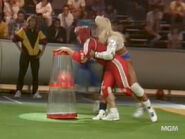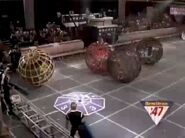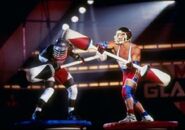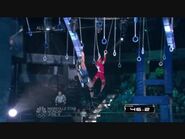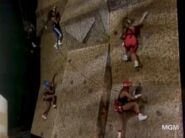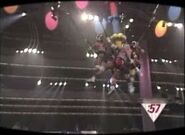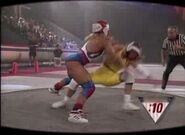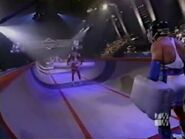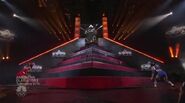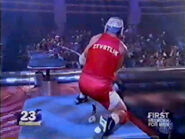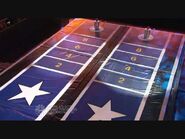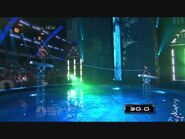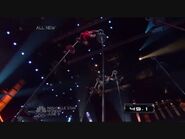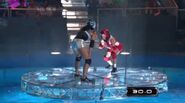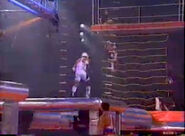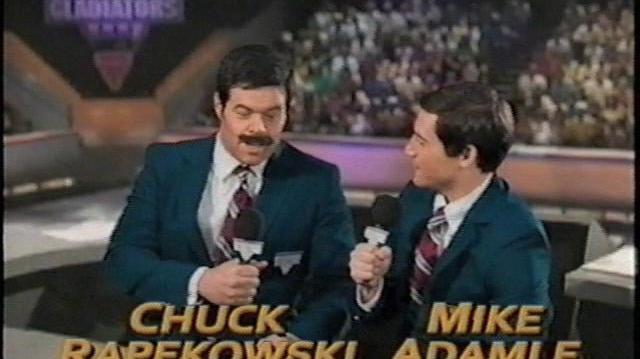| Hosts | |
|
Mike Adamle 1989-1996 | |
| Announcers | |
| John Harlan 1989-1991 Van Earl Wright 2008 | |
| Broadcast | |
| Syndicated: 9/9/1989 - 5/11/1996 ABC "Superstar Special": May 4, 1995NBC: 1/6/2008 - 8/4/2008Telemundo "Gladiadores Americanos": 2008 (Spanish dubbed broadcasts of English version) | |
| Packagers | |
| Trans World International/Four Point Entertainment 1989-1996 FLOR-JON Films/Reveille Productions/Room 403 Productions 2008 | |
| Distributors | |
| The Samuel Goldwyn Company 1989-1996 MGM Television 2008 | |
American Gladiators was a competition television program that matched a cast of amateur athletes against each other, as well as against the show's own "gladiators", in contests of strength and agility.
Referees
Bob McElwee 1990
Larry Thompson 1990-1996
Al Kaplon 2008
The American Gladiators
1989-1996
Female
Blaze - Sha-ri Pendleton 1990–1992 (once rumored to be dead, only to be confused with former contestant Cheryl Wilson, a heptathlete from LSU who competed in Season 4)
Dallas - Shannon Hall (second half of season five) (returned with Zap to compete in alumni show in the final season)
Diamond - Erika Andersch 1990–1993 (also competed in BOTH the Orlando and Lafayette Live Shows. She temporarily appeared as "Lightning" in the British Version of "Gladiators," but another woman with the same name didn't appreciate this, so she switched back to "Diamond")
Elektra - Salina Bartunek 1992–1994 (competed part time after breaking her nose in 1993 Grand Championship, plus she can speak eight different languages and was the translator for the deaf Gladiator Siren.)
Gold - Tonya Knight 1990–1992
Ice - Lori Fetrick 1990–1992, 1993–1996 (a rough and tough Gladiator with a warm heart; her biggest feud was against Denise Chase, who defeated Ice TWICE in the same event: The Joust)
Jade - T.C. Corrin 1989 (competed in final episode of first half of season one as injury replacement for Sunny, never seen afterwards, due to an injury to herself) (A NEW Jade appeared in the Orlando Show, but she was quickly kicked off the show due to her extremely aggressive attitude)
Jazz - Victoria Gay 1993–1996
Lace (1) - Marisa Pare 1989–1992
Lace (2) - Natalie Lennox 1992-1993 season (competed in just two episodes) (In late 1992, Lennox reappeared in the British Version "Gladiators" as "Star")
Siren (1) - Shelley Beattie 1992–1996 [the only deaf Gladiator (she attempted suicide and died in 2008 prior to the revival from hanging herself)]
Sky - Shirley Eson-Korito 1992–1996 (the tallest female gladiator at 6'3") (Sky is also a chocoholic and possesses a very sweet attitude. Most fans, Gladiators and contenders loved Sky for that very reason)
Storm - Debbie Clark 1991-1993 (started as an injury replacement for Gold) (Storm was powerful, but extremely aggressive. Especially in Season 4)
Sunny - Cheryl Baldringer 1989 (left after being injured in semifinal round during Breakthrough and Conquer) (Sunny was "The All-American Woman" and the biggest of the three female Gladiators (Zap, Lace and Sunny). A rumor is flying around that Sunny is currently dating former Gladiator Malibu, but nothing is known for sure.)
Zap - Raye Hollitt 1989–1990, 1991–1995
Male
Atlas - Philip Poteat 1992-1993 season
Bronco - Robert Bruce Campbell 1989 (competed in one episode as an injury replacement for Malibu, was never seen again)
Cyclone - Barry Turner 1992-1993 season (competed in preliminary rounds but suffered with an injured arm and didn't return)
Gemini - Michael Horton 1989–1992
Havoc - 1992-1993 season (part time Gladiator)
Hawk - Lee Reherman 1993–1996
Laser - Jim Starr 1990–1996 (only Gladiator to appear on all seven seasons of the show)
Malibu - Deron McBee 1989
Nitro - Danny Lee Clark 1989–1992, 1994-1995 (returned as co-host during final season in its first run, coordinating producer of the 2008 revival)
Rebel - Mark Tucker 1993-1994
Sabre - Lynn "Red" Williams 1992-1996
Tank - Ed Radcliffe (competed in three episodes of season five as an injury replacement for Laser)
Thunder - Billy Smith 1990–1992
Titan (1) - David Nelson 1990
Tower - Steve Henneberry 1991-1994 (started as an injury replacement for Turbo)
Turbo - Galen Tomlinson 1990–1996
Viper - Scott Berlinger 1992-1993 (debuted at 1992 Grand Championship)
2008
Female
Crush - Gina Carano
Fury - Jamie Reed (Season 1) (Related to Gladiator Toa)
Hellga - Robin Coleman
Jet - Monica Carlson (Season 2) (Season 1 Champ)
Panther - Corinne van Ryck de Groot (Season 2)
Phoenix - Jennifer Widerstrom (Season 2)
Siren (2) - Valerie Waugaman
Stealth - Tanji Johnson (Season 1)
Steel - Erin Toughill (Season 2)
Venom - Beth Horn
Male
Beast - Matt Morgan (Season 2)
Hurricane - Breaux Greer (Season 2)
Justice - Jesse Justice Smith, Jr.
Militia - Alex Castro
Mayhem - Romeo Williams (Season 1)
Rocket - Evan Dollard (Season 2)
Titan (2) - Mike O'Hearn (was once a warrior on Battle Dome)
Toa - Tanoai Reed (Related to Gladiator Fury)
Wolf - Don "Hollywood" Yates
Zen - Xin Wuku
Gameplay
Four amateur athletes (two men & two women) face off in a series of events against not only each other, but also the force of the American Gladiators. There were two match-ups per show, one for the men & one for the women so there would always be a man & woman champion.
Events
Original
- Assault (entire run): The contenders had to fire a series of 5 weapons to hit a target at 1 end of the playing field. A Gladiator used a cannon to shoot tennis balls at 100 miles per hour at the contenders. The weapons used by the contenders were a Rocket Launcher, a Cannon, a Pistol, Grenades, a Crossbow, a Push-Gun, and softballs. The weapons changed from season to season with the weapons being used in an exact order. Hitting the inner rim above the Gladiator earned the contender 100 points, 60 points (later 75 points) for hitting the outer rim, and 30 points, if the 4th weapon was fired and if the contender remained at the final station until time ran out. During the second half of the first season, hitting the target was now only worth 7 points, hitting the bulls-eye was only worth 10 points, and 4 points for crossing the finish line.
- From the 3rd season to the rest of the run, hitting the target period was now worth 10 points. If s/he unable to hit the target, s/he received 1 point for each weapon fired, and 1 bonus point for crossing the finish line within 60 seconds.
- In the original, should the contender hit the target, the gladiator was blasted with a smoke screen effect. While in the 2008 revival, should the contender hit the target, the gladiator was blasted and dunked into the pool.
- Breakthrough & Conquer (entire run): In the Breakthrough part, a contender had to carry a football 15 yards to an end zone against 1 Gladiator. In the Conquer part, a contender had to wrestle a different Gladiator out of the ring within 10 seconds (15 seconds in the 4th season). Each successful part was worth 30 points (later 40 points) and winning the whole event was worth 100 points.
- During the second half of the first season to the rest of the run, 3-5 points were for each successful part of the event.
- Joust (entire run): A Contender and a Gladiator compete in a pugil stick battle, each trying to knock his/her opponent off a wooden bridge. 30 points was awarded for competing in the event, 5 points was awarded for every 5 seconds (up to 75 points), the contender stayed on the bridge, and a win was worth 100 points. In the second half of the season on, the bridge was replaced with podiums.
- Powerball (entire run): Contenders compete against 3 gladiators. The contenders grabbed a colored ball from a bin and had to deposit it into 1 of 5 scoring cylinders on the floor within 45 seconds. If a Gladiator tackled or knock a contender out of bounds, the contender had to get another ball and try again. Contenders received 15 points for each score. During the second half of the first season, contenders received 1 point for outside cylinder goals and 2 points for center cylinder goals.
- From the second season to the rest of the run, contenders received 1, 2, or 3 points for outside cylinder and 3, 4, or 5 points for center (depending on the round number).
- Human Cannonball (1989-90, 1992-93): Contenders stood on a raised platform and a Gladiator stood on a lower platform. Contenders had to swing on a rope to knock the Gladiator off the pedestal. A contender had to knocked down 3 Gladiators (later 2 Gladiators). Each successful swing was worth 30 points (3 points in the second half of season 1) with 10 bonus points (1 bonus point in the second half of season 1) for 3 successful swings. In the second season, each contender only got 2 chances and each successful swing was worth 5 points. This event returned for the 4th before it was axed for good due to safety reasons.
- Atlasphere (1990-94): Contenders were in large metal cage-like spheres, rolling them towards scoring pods, but the Gladiators had their own spheres to keep the contenders from scoring. The contenders had to score as much points in 60 seconds. Scoring pods were worth 1-3 points.
- Hang Tough (1990-96): A contender stood on a raised platform and a gladiator stood on another. The contender had 60 seconds to swing to the gladiator's platform through a 55 foot field without being pulled off by the gladiator. Contenders received 10 points for swinging to the Gladator's platform, 5 points for a draw, or 7 points if a contender was in the red ring area for draw (this was eliminated after the second season).
- The Wall (1990-96): The Contenders had 2 minutes (later 60 seconds) to climb up the top of the wall. The men were given a 10 second head start and the women were given a 15 second head start. The first contender to make it to the top received 10 points and the second contender to make to the top received 5 points. During the first 2 seasons of this event, each contender received 5 points if they failed to reach the top. In the 3rd season, all head starts were 10 seconds. In the 5th season, head starts were dropped.
- The Maze (1991-93): The Contenders had 45 seconds to run through the maze trying to find the exit with four Gladiators preventing them from finding it. There are actually two ways out of the maze and it didn't matter if both contenders come out of the same one or not. The first contender to find the exit received 10 points and the second contender to find it received 5 points.
- Swingshot (1991-96): The Contenders competed against 3 Gladiators (later 2 Gladiators) and had 60 seconds to grab as many colored balls hanging in the air connected to bungee cords. They leaped off designated platforms, grabbed colored balls and put them in their baskets. When time ran out, only the colored balls that are in the baskets count. Red balls were worth 5 points (later 3 points), Blue balls were worth 3 points (later 2 points), and Yellow balls were worth 1 point.
- Sky Track (1992-95): Contenders were suspended by a harness and would race upside-down on a track from the ceiling of the arena. The first contender to reach to the finish line received 10 points and the second contender to do it received 5 points.
- Super Powerball (1992-93): Same as regular Powerball with only 3 cylinders. The outer cylinders were worth 3 points and the center cylinder was worth 5 points.
- Gauntlet (1993-96): Contenders had 25 seconds (later 20 seconds) to run through a chute and past 5 Gladiators (later 4 Gladiators) with pads to try to stop the contenders' progress. Passing all the Gladiators was worth 5 points, but if s/he pass all the Gladiators with more than 5 seconds left, s/he received 10 points.
- Pyramid (1993-96): The Contenders had 45 seconds to climb up a 42 foot pyramid of red and blue mats to reach the top and press a button to receive points. 2 Gladiators were at the top to keep them from reaching to the top. The first contender to reach the top received 10 points and the second contender to reach the top received 5 points.
- Tug-O-War (1993-96): A contender and a gladiator each stood on a platform and pulling a rope. The contender had 30 seconds to pull the gladiator off of his/her platform for 10 points or 5 points for more than 30 seconds.
- Whiplash (1994-96): A contender and a gladiator each grasped at 1/2 of a double-triangle shaped item called "The Bone" and had 30 seconds to pull the bone out of his/her opponent's grasp. If the contender pulled the bone out of the gladiator's grasp, s/he received 10 points or 5 points for a draw.
- Snapback (1994-96): The Contenders and 2 Gladiators were attached by a bungee cord and had 45 seconds to grab as many colored markers as s/he can and deposit them in a bin. S/he received 3 points for each blue marker and 2 points for each red marker. Later in the run, blue marker were only 2 points and red markers were only worth 1 point.
Revival
- Earthquake: A contender and a gladiator stood on a suspended ring held by three wires and over the pool (crash mat in the 1st season). The contender had 30 seconds to take the gladiator off the ring (even if they get taken off) earning 10 points in the process. 5 points are awarded if both the gladiator and the contender stayed on when time was up.
- Hit & Run: One contender faces four Gladiators, two on each side of the bridge, and must traverse (cross) the bridge as many times as possible during the next 60 seconds. 2 points are awards each time that feat was accomplished. The gladiators tried to knock the contender off the bridge by swinging their demolition balls at him/her. The game ends when either the time limit expires or when the contender is knocked off the bridge.
- Rocketball: Both contenders faced two gladiators (one gladiator per contender). They all start at the corner of the playing field marked by four posts with a button on top of them. Near each Contender's button is a bucket filled with balls of their color. The buckets and balls are the same ones used in Powerball. In the center of the arena, 20 feet off the ground, is a pole with two baskets attached, Red on top, Yellow on the bottom. The event itself was played similar to Swingshot. The contenders had 60 seconds to place their respective colored balls into their baskets above the arena floor. Contenders are launched into the air towards the scoring buckets by pressing the button at their posts.
- Sideswipe: The contender had 60 seconds to work his/her way across five platforms twelve feet above the water and throwing balls at targets located on the ends. The contender had 60 seconds to play and he/she scored one point for each ball in the target. It wasn't easy because three gladiators postioned at platforms in front of the wall swung across on ropes in an attempt to knock the contender off the platform(s).
- Tilt: This was based on the event from the original version, only here the contender & gladiator each stood at tilting platforms and they were standing over water. The contender had 30 seconds to pull the gladiator off of his/her platform for 10 points or 5 points for more than 30 seconds.
- Vertigo: A contender and Gladiator race across separate courses of tall swaying poles spread across the arena floor whith a hoop at the end. The first participant to reach the end andgrab the hoop wins; the contender recieved 10 points for the completed work.
The Eliminator
The competition always ended with "The Eliminator", an obstacle course that decided the winner.
As time went on, the Gladiators had a minor role in operating the course, up to the point where the Gladiators were removed from the course altogether.
Originally, The Eliminator was played to time (originally 60 seconds for all contestants, later 75 seconds for the women & 90 seconds for the men) and every second leftover awarded points (originally 5, later 2) for contenders who finished the course. Falls, damages or violations incurs penalties. The contender with the most points won the competition, which meant that the trailing player would have to win by a certain amount of time to win. Ties were broken by the fastest time. But after the second season, The Eliminator was simply made a race to the finish; the player in the lead was given a 1/2 second head start times the difference between his/her score and opponent's score. Naturally, the first player to cross the finish line won the competition.
List of Eliminator Obstacles
| Season | Eliminator Course | ||||||||||||
|---|---|---|---|---|---|---|---|---|---|---|---|---|---|
| Original Run | |||||||||||||
| 1 | Weighted Ball Push | Balance Beam | Commando Lines | Swing for Life | Cone Slalom | Wall of Gladiators Finish | |||||||
| 2 | Treadmill | Hand Bike | Balance Beam | Cargo Net | Zipline | Two Hurdles | Wall of Gladiators Finish | ||||||
| 3 | Treadmill | Hand Bike | Spinning Cylinder | Cargo Net | Zipline | 8 foot wall | Medicine Ball Gauntlet/Second 8 foot Wall | Corridor Sprint | Final Hurdle to Finish Line | ||||
| 4 | Treadmill | Hand Bike | Spinning Cylinder | Cargo Net | Zipline | Plexiglass Wall | Blocking Dummy Gauntlet | Final Hurdle and Race through Finish | |||||
| 5-6 | Versaclimber | Slide | Hand Bike | Spinning Cylinder | Cargo Net | Zipline | Plexiglass Wall | Treadmill | Rope Swing Finish | ||||
| 7 | Versaclimber | Slide | Hand Bike | Ball Pit | Cargo Net | Zipline | Plexiglass Wall | Treadmill | Rope Swing Finish | ||||
| 2008 Revival | |||||||||||||
| 1 | 8 foot wall | Swim under Fiery Surface (20 Feet) | Cargo Net | Barrel Roll | Hand Bike | Balance Beam | Pyramid | Zipline | Travelator (The Treadmill) | Steps | Finish Blocks | ||
| 2 | Swim under Fiery Surface (40 feet) | Cargo Net | Rope Swing | Tightropes | Hand Bike | Ball Pit | Inclined Spinning Cylinder | Pyramid | Zipline | Teeter Totter | Travelator | Steps | Rope Swing Finish |
Tournament Formats
Each of the first four seasons featured two half-season tournaments every year with each tournament winner competing in the Grand Championship. During the first two seasons, each half-season featured five preliminary matches and the winners from each match along with the three highest scorers from each gender competing in the quarterfinals. Each winning quarter-finalist advanced into the semifinals and each winning semifinalist advanced into the finals match with each semifinal runner-up taking home $2,500. Each winning finalist won $10,000 and competed in the Grand Championship at the end of the season, with each runner-up finalist taking home $5,000.
During seasons three and four, each half-season consisted of six preliminary matches. The quarterfinals consisted of three matches and each gender's three winning quarter-finalists and highest-scoring runner-up advanced to the semifinals.
In season five, each half-season featured four preliminary matches and each gender's eight competitors were seeded based on their performance before the single-elimination tournament began.
Each of the first five Grand Championships awarded $15,000 to each gender's Grand Champion and $10,000 to each runner-up. In addition during the first four season, each Grand Champion also won a car (a Chevrolet automobile of the contender's choice for season one and two, a Chevrolet Blazer during season three and a Suzuki Sidekick in season four). Each of the first four Grand Championships also awarded a Club Med vacation to each runner-up. The fifth annual Grand Championship only awarded cash.
Seasons six and seven each featured a season-long tournament which awarded $2,500 to each preliminary winner. The four top scorers at the end of each season competed in the semifinals for an additional $10,000 and a berth in the Grand Championship. Each Grand Champion from the sixth season won $15,000 and each Grand Champion from season seven won $10,000 and the right to compete in International Gladiators 2.
In the first season of the 2008 revival, each of the six preliminary matches featured four events being played prior to the Eliminator. In each semifinal as well as the finals match, five events and the Eliminator would be played. The four fastest winners from each gender competed in the semifinals.
In season 2, six events would be played, except for the first two shows, each of which featured two events before the Eliminator. Twenty of each gender competed in the quarterfinals and the six fastest Eliminator winners in each gender competed in the semifinals with the two fastest winners from the three semifinals competing in the Grand Championship.
Each Grand Champion won $100,000 and a Toyota Sequoia. The first Grand Champions also participated as American Gladiators during the second season.
Gallery
Events Gallery
Video
Potential Revival
In 2014, some news reports said that a reboot of the show was in the works with Arthur Smith of A. Smith & Co. Productions.[1]According to Smith, he says that "It's a little darker, more intense and more serious." he also mentions that "It's a little less red, white & blue. And there's no spandex." claiming that "Spandex has left the building". The reboot would also incorporate elements that were inspired by the popular film franchise The Hunger Games along with mixed martial arts saying that "Times have changed" as "It's more post apocalyptic, but it's the same spirit". Development for the reboot was made for the past several months and was shopped to broadcast and cable networks in the coming weeks. However, the planned reboot has backfired since then.
Online, on Tour and Into Animation
Since 2008, MGM franchised American Gladiators as a Broadband Website, a Tour and as a potential cartoon.[2]
Broadband Website
On January 28, the studio will launch a broadband website that will pay homage to the original series, americangladiators.com where the site will feature clips of the original series which have all been re-digitalized as clips will reintroduce original Gladiators and give fans an update on where they are today. Feature segments will also include "Best Hits" and stunts performed on the vintage show.
Tour
On the heels of the website launch, MGM, Reveille and Flor-Jon, Films Inc. will unveil a special American Gladiators U.S. cross-country tour.
Cartoon
MGM along with Johnny Ferraro, owner of Flor-Jon, Films Inc. have put into development a cartoon series based on the franchise but has never aired on television since then.
Potential Film
In 2009, Johnny Ferraro creator of American Gladiators once wanted to bring a live-action version[3] of the show as a film based on it. Former Legendary Pictures chief marketing officer Scott Mednick was producing the film where the goal was to create an action story that takes place inside the world Ferraro created. In addition, the series was originally conceived as a film. But has never be made.
Controversial Gladiators
Debbie "Storm" Clark
In 2011, news reports said that one of the female gladiators from the original series named Debbie Clark ("Storm") made only $1,500 a day[4][5]. since that time, she and her 10-year-old son Crayton have been homeless in San Diego for more than two years after fleeing from a domestic violence situation in South Carolina. Clark was also in pain from knee injuries as she has to deal with her son's food allergies and ADHD. However, in the same year, comedienne, talk show hostess and former host of The Newlywed Game, Sherri Shepherd helped get back on her feet by promising to pay six months' of rent, gas and electrical costs.
Alex "Militia" Castro
In 2007, according to The New York Post[6]one of the "Gladiators" from the short-lived 2008 NBC version named Alex Castro ("Militia") claimed that he was a "gay porn star" as various naked pictures along with a film of Castro have turned up on gay porn sites and were first reported last week by the Internet Gossiper himself named Perez Hilton.
Music
Bill Conti
Inventors
Dan Carr and John Ferraro
Rating
Additional Page
American Gladiators/Merchandise
Spinoffs
Gladiators 2000 - a children's spinoff of American Gladiators
Trivia
This show also aired dubbed in the Spanish language on Telemundo as Gladiadores Americanos. The only major difference was the change of the title logo, though the main logo on the stage remained unchanged.
In Popular Culture
In the sitcom Family Matters, a September 18, 1992 episode called "Surely You Joust", Steve Urkel (Jaleel White) & Carl Winslow (Reginald Vel Johnson) competed in a episode of American Gladiators.
In a December 1992 issue of MAD magazine, American Gladiators was spoofed as American Radiators.
In the sitcom Ellen, a March 1, 1995 episode somewhat appropriately titled "Gladiators" the titular character Ellen Morgan (Ellen DeGeneres) was a contender for the show. While preparing for the show, she fell in love with Dan "Nitro" Clark, (one of the "Gladiators") but love turn to hate when female gladiator Lori "Ice" Fetrick tried to mess it up. So when Ellen learned that she'll face Ice in "Joust", that's what gave her the opportunity to "cream" Ice for butting in. Nitro tried to forgive Ellen, but he got whacked by her with the "pugil stick" too. Ellen was later disqualified, but she got an American Gladiators hat as a souvenir.
A parody film of American Gladiators called American Flatulators was a "straight to VHS" released in 1996; click on the "references" page for the description of the film.[7]
In the 2002 Looney Tunes video game Taz: Wanted, a boss battle against Daffy Duck plays out very similarly to the Atlasphere game.
In the 2008 spoof film flop Disaster Movie, the short-lived NBC version was briefly spoofed where in the year 10,001 B.C., a caveman named Will (played by Matt Lanter) runs away from a predator through a plain and immediately gets into a fight with Wolf (played by Ike Barinholtz of MAD TV fame) and defeating him.
Reference
- ↑ Exclusive: Revived American Gladiators To Get Modern Makeover
- ↑ MGM Takes 'American Gladiators' Online, on Tour and Into Animation
- ↑ American Gladiators: The Movie is Coming - Not a Joke
- ↑ Former American Gladiator Is Now Homeless
- ↑ 'View' Host Offers Help To Homeless Ex-'American Gladiator'
- ↑ THE BARE FACTS
- ↑ American Flatulators (1996)
Links
- Official Site
- Official Website of the short-lived 2008 revival (courtesy of "Internet Archive")
- Josh Rebich's American Gladiators Rule Sheet





